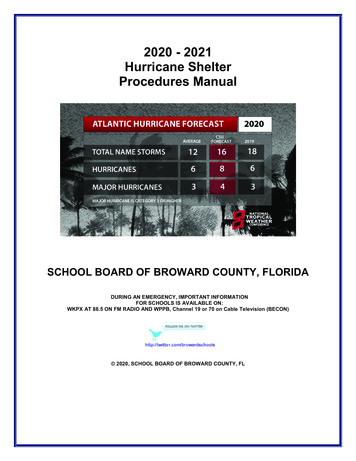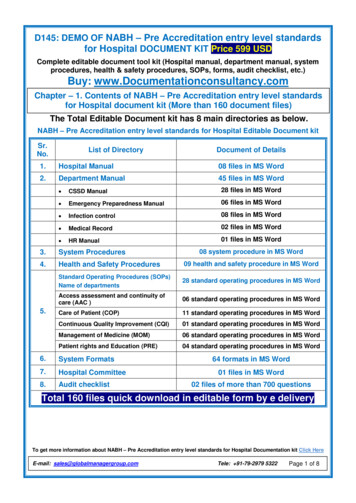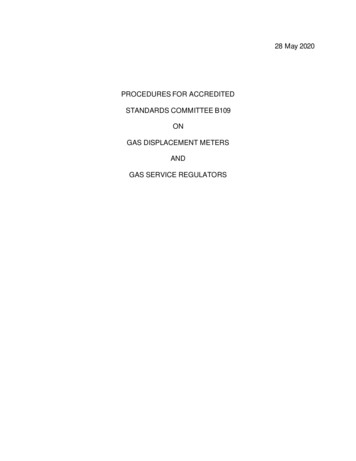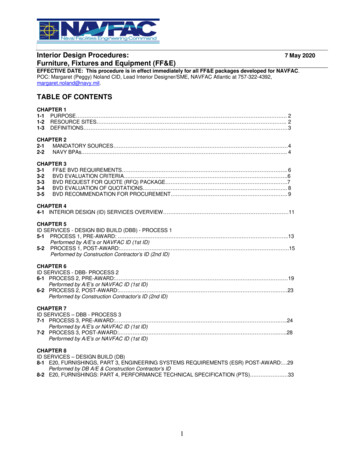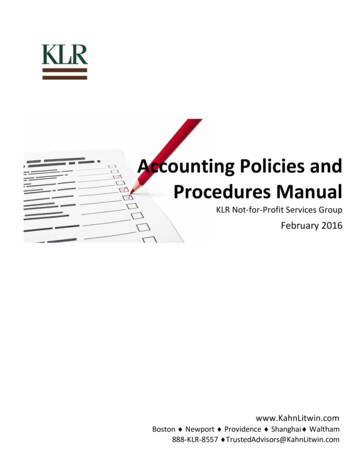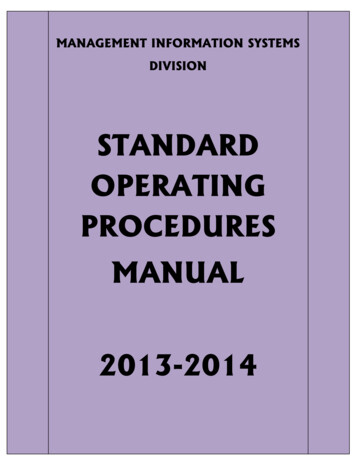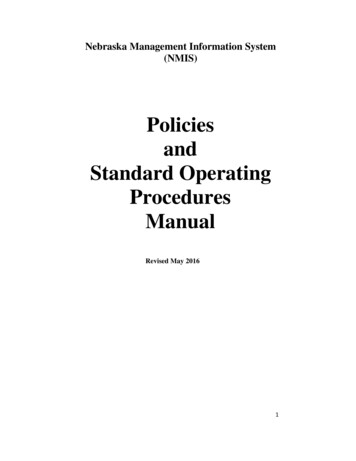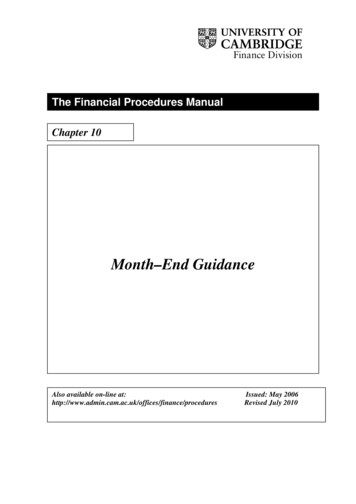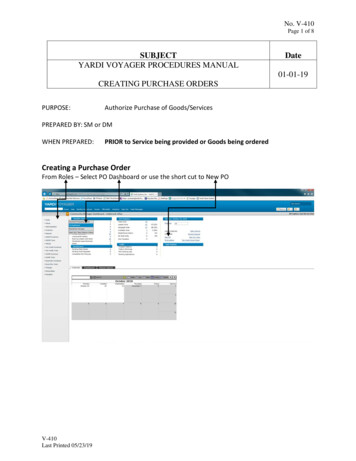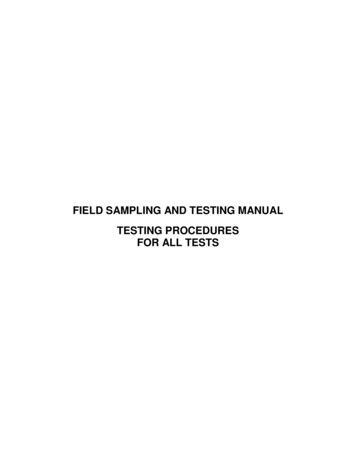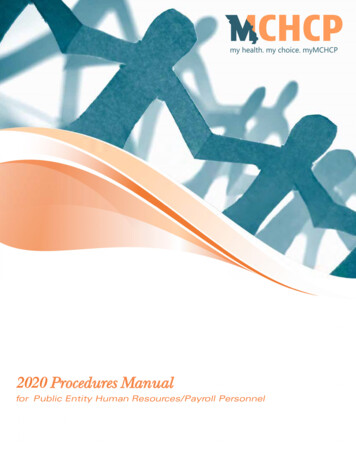
Transcription
2020 Procedures Manualfor Public Entity Human Resources/Payroll Personnel
IntroductionUse this manual, the Benefit Guide and code of state regulations at 22 CSR 10-3to learn about employee health benefits through Missouri Consolidated HealthCare Plan (MCHCP) and the requirements for a public entity to remain withMCHCP.As MCHCP guidelines change, this manual is updated. Your suggestions andcomments are welcome and appreciated because you provide a vital linkbetween public entity employees and MCHCP.
Table of Contents4-9 Contact Information14-18 EnrollmentPlan Contact Information. 4Waiving Coverage. 9New Employees. 910-13 EligibilityDefinitions. 5Employee Classification. 5Eligibility Requirements. 5-6Participation Levels.6-7Contribution Levels. 7Eligibility Changes. 8Termination Policy. 8Dual Coverage. 9Transfers. 9Terminations. 10Open Enrollment. 10Notifying MCHCP of Changes. 10COBRA. 10–11Certificates of Coverage. 1117-18 BillingPayment and Refund of Premium. 12Understanding your Bill. 12ACH Payment Option. 13Delinquent Account Policy. 13
4Contact InformationPlan Contact InformationMCHCPVision PlanPrescription Drug PlanMissouri ConsolidatedHealth Care Planwww.mchcp.org800-487-0771 or 573-751-0771TTY: 800-735-2966Fax: 866-346-8785National Vision Administrators,L.L.C. (NVA)www.e-nva.comUser Name: mchcpPassword: vision1877-300-6641Express Scripts, Inc. (ESI)www.express-scripts.com800-797-5754Monday – Friday8:30 a.m. – 4:30 p.m.(excluding state holidays)24 hours a day832 Weathered Rock CourtPO Box 104355Jefferson City, MO 65110–4355Medical PlanAnthem Blue Cross and BlueShieldwww.anthem.com844-516-0248 (MemberServices) 866-962-1395 (24/7NurseLine)Monday - Friday7:00 a.m. - 6:00 p.m.Claims AddressPO Box 105187Atlanta, GA 30348â “5187Dental PlanMetLifewww.metlife.com/mchcp844-222-9106Monday - Friday7:00 a.m. - 10:00 p.m.Claims AddressesAttn: MetLife Dental ClaimsPO Box 14588Lexington, KY 4051224 hours a dayHome Delivery PharmacyServicePO Box 66773St. Louis, MO 63166-6773Claims AddressAttn: ClaimsPO Box 2187Clifton, NJ 07015Strive Employee LifeFamily (SELF) ProgramComPsych www.guidanceresources.com800-808-2261To access services, visitmyMCHCP or call MCHCPMember Services&Claims AddressExpress ScriptsAttn: Commercial ClaimsPO Box 2872Clinton, IA 52733-2872Fax: 608-741-5475Accredo Specialty Pharmacy800-803-2523TTY: 877-804-9222
2020 Public Entity Procedures ManualEligibilityDefinitionsThroughout MCHCP publications, including thismanual, we frequently use the following terms: Subscriber - The employee or survivor whoelects coverage under the plan Member - Any person covered as either asubscriber or a dependent in accordance with anemployee benefit plan Health Plans - Any medical, dental, vision oremployee assistance plans offered by MCHCPEmployee Classification Active - Employees eligible to receive healthinsurance benefits. The public entity mayset a minimum average number of hoursworked per year to establish eligibility. Thisclassification may include: full-time, part-time,seasonal, long-term disability (LTD), leave ofabsence employees, and elected/appointedofficials while in office.Employees under this classification appear onthe bill as active employees and receive activeemployee premiums. If a public entity isresponsible for the salary and taxes of seasonalemployees, seasonal employees may beeligible for benefits Retiree - A retiree is defined as a formeremployee who, at the time of retirement, isreceiving an annuity benefit from an entitysponsored retirement system Survivor - A dependent of a deceased vestedactive employee, terminated vested subscriber,vested long-term disability subscriber, or aretiree of a public entity with a retirementsystem. Survivors may be eligible to continuecoverage if they meet the eligibility criteria andthe public entity employer continues coveragewith MCHCP Dependent Children - Generally, when adependent child turns 26, the participant-onlyCOBRA premium applies, not the child-onlypremium. The child-only premium applieswhen an employeeterminates employment and continues coverageon his or her children through COBRA. Childrenmay be covered up to the end of the month inwhich they turn 26.Children age 26 or older may continue coverageif they became permanently disabled prior toage 26. New employees may add eligibledisabled dependents as long as the disabilityoccurred prior to age 26, with proof ofeligibility.Eligibility RequirementsThe following sections explain eligibilityrequirements and other pertinent information forpublic entities participating with MCHCP.Employees and DependentsHealth plans contracted with MCHCP must bemade available to all eligible employees and theirdependents. An eligible employee is activelyemployed and meets the minimum number ofhours worked per year as established by his orher employer. If the public entity allows elected/appointed officials to participate in the health plans,they are considered eligible employees. MCHCPprovides coverage for existing COBRA participantsuntil their eligibility period expires or until thepublic entity terminates coverage with MCHCP,whichever occurs first. The entity determines someeligibility guidelines, such as probationary periods,required number of working hours, pay status andcontribution level.Retirees and their DependentsThe health plans must be made available to allretirees and their dependents. The entity must makethe benefits available to all retirees who meet thevesting requirements. Retirees remain eligible aslong as the entity remains with MCHCP. Employeesmay continue on COBRA if they are not eligibleretirees or if they do not wish to continue coverageas a retiree.5
6EligibilityEligibilityRetirement System DefinitionFor an eligible employee to continue coverage as aretiree, a retirement plan must be in place. If neitherof these scenarios is applicable and no retirementplan exists, employees are ineligible for retireehealth benefits. Below are two types of retirementplan options recognized by MCHCP: An established retirement plan withcontributions shared by both the employee andthe employer (or made by the employer only)with an established minimum vesting period.Under this option, the employer must offercoverage to retirees who meet the minimumvesting requirement An employer-sponsored (but no contributionmade by employer) retirement plan in whichthe employee is currently participating or fromwhich the employee is eligible to receive abenefit. In this case, to be considered an eligibleretiree, the prospective member must have meta vesting criterion equal to that of the MissouriState Employees’ Retirement System (MOSERS).If this criterion is not met, the employer may notoffer coverage to that person as a retireeParticipation LevelsA specific number of employees are required toparticipate within a plan for the public entity to offerhealth benefits.AuditsAudits will be conducted annually to ensure entitiesmeet these requirements.To verify participation, each entity must providea copy of its Missouri Quarterly Contribution andWage Report annually with the Selection of Offeringsform. Proof of other coverage for those waivingcoverage will also be required.Medical PlanIn determining an entity’s participation level, MCHCPexcludes eligible employees who waive coveragethrough MCHCP because they have other groupcoverage. Other group coverage includes TRICARE,an employer-sponsored health plan, Medicare orMedicaid (MO HealthNet). Proof of other coverage isrequired to exclude employees when calculating theparticipation level.MCHCP shall be the only medical option availableto the entity’s employees, their dependents andretirees.Employers with three or fewer employees are notsubject to the 75 percent participation requirement.Employers with four or more eligible employeesmust maintain 75 percent of all eligible employeesparticipating in the medical plan.EXAMPLE: Public Entity A has 125 eligible employeeson the payroll. Twenty-five of those employees donot participate in the plan, but they have coveragethrough plans offered by their spouses’ employers.This leaves a total of 100 eligible employees. MCHCPrequires that 75 of these employees participate inthe medical plan.Dental PlanThe public entity is required to maintain medicalparticipation requirements to offer the dental plan.A subscriber and his or her dependents may enrollin the dental plan even if the subscriber waivesmedical coverage. The subscriber must enroll indental for his or her dependents to participate. Thesubscriber’s level of coverage for dental does nothave to match the level of coverage for medical.The same number of employees and 50 percentof dependents covered by the medical plan mustparticipate in the dental plan. The number of
2020 Public Entity Procedures ManualEligibilityParticipants in the dental plan must meet or exceed thenumber in the medical plan, but it does not have toinclude the same employees.EXAMPLE: There are 25 total employees, and 22 of themenroll in the medical plan. In this case, 22 employeesalso need to enroll in the dental plan. If 14 dependentsenroll in the medical plan, then seven dependents mustenroll in the dental plan.Vision PlanYou and members of your household can keep usingthe SELF program for 18 months following yourretirement and through the month after you are laidoff. Your household members can use the SELFprogram for six (6) months after your death. Detailedinformation about the SELF program can be found onour MCHCP website at mchcp.org.The SELF program is paid by the employer and requires100 percent participation of employees eligible formedical coverage and can be expanded to additionalclassifications. This includes employees who waiveother coverage.The public entity is required to maintain medicalparticipation requirements to offer the vision plan. Aswith the dental plan, a subscriber and his or herdependents may enroll in vision even if the subscriberwaives medical coverage. The subscriber must enroll invision for his or her dependents to participate. Thesubscriber’s level of coverage for vision does not have tomatch the level of coverage for medical.This is the only benefit in which an employee mayhave dual coverage.The vision plan has no participation requirements.Medical PlanStrive Employee Life & Family (SELF) programis available to eligible employees and members oftheir household 24 hours a day, every day of theyear. The SELF program offers the following at no costto you: Local, Private, In-Person Counseling for every dayissues like stress, substance use, grief and loss. Getup to six (6) counseling sessions per problem, perperson, per year; FinancialConnect to assist with a wide range ofmoney issues, such as retirement planning andsaving for college; LegalConnect to talk on the phone with anattorney for legal help, ask questions and plan nextsteps; IDResources to talk to on the phone with anidentity theft or fraud resolution specialist; FamilySource call or go online to get expert helpwith every day issues, such as child and elder care,moving and relocation and vacation planning; GuidanceResources is an online library ofresources for health, wellness, consumer, family,career, education and more;EXAMPLE: Bob and Sue are married. They each workfor an entity covered by MCHCP offering the SELFprogram. Bob and Sue are each eligible to use the SELFprogram's benefits under both employer plans.Contribution LevelsActive employees and elected/appointed officials The public entity must contribute at least 50percent toward the lowest-cost employee-onlymonthly premium for each participating employee If elected/appointed officials are eligible toparticipate, this minimum contribution applies tothem as wellRetirees No contribution requirement for retireesDependents No contribution requirement for dependents.Dependents are eligible for all plans, as long as theemployee is enrolledDental PlanThe employer must contribute at least 50 percenttoward the employee-only monthly premiumVision PlanNo employer contribution is required toward themonthly premiumStrive Employee Life & Family (SELF) program Theemployer must contribute 100 percent of the monthlypremium7
8EligibilityEligibilityEligibility ChangesTermination PolicyA public entity may change its eligibilityrequirements during any of the following:Chapter 103 of the Revised Statutes of Missouriallows MCHCP to terminate an entity for any of thefollowing reasons: During the annual Open Enrollment period.The public entity must submit the Selection ofOfferings form stating the new policy. The policywill go into effect Jan. 1 of the following year Thirty (30) days prior to the end of its fiscal year.The public entity’s top administrator must writea letter requesting the change A new employee classification is added tothe public entity. The determination of thisemployee classification for eligibility is at thediscretion of the public entityWaiting/Probationary PeriodsA waiting/probationary period is the length oftime the employer requires an employee to beemployed before he or she is eligible for healthinsurance coverage. Public entities may set differentwaiting/probationary periods for differentemployee classifications (for example, full-time vs.part-time).EXAMPLE: John begins employment with the publicentity on January 25. John has a 90-day waitingperiod. John becomes eligible to enroll in MCHCPcoverage on April 25. John's 31-day eligibilityperiod to enroll in MCHCP coverage begins on April25. Failure to pay premiums in a timely manner Failure to abide by the terms and conditions ofthe Participation Agreement Failure to maintain participation requirements Failure to abide by the applicable provisionsof Chapter 103 or rules and regulationspromulgated by MCHCP Insufficient funding is received by MCHCP tocontinue the planA public entity may terminate voluntarily with 90days written notice prior to the end of the contractperiod.
2020 Public Entity Procedures Manual9Enrollmentemployee/spouse (if allowed by the employer), but notboth.New EmployeesEXAMPLE: An employee works for Public Entity A,which offers MCHCP products. His or her spouse worksfor Public Entity B, which also offers MCHCP products.The employee is required to select one entity throughwhich he or she wants to enroll. The employee cannotbe covered as both an employee and a dependent.Employees eligible for coverage must submit acompleted enrollment form to MCHCP for coveragewithin 31 days of the eligibility date. If the enrollmentform is received before the eligibility date, coverage maybegin on that date or the first of the following month.The employee and the Human Resources Officersignatures are required on the Enroll/Change/Cancel/Waive form. Employees who fail to enroll during the 31day period may enroll during the next Open Enrollmentfor coverage to being the following January.EXAMPLE: Jane begins employment with the publicentity on January 25 and the pay rep submits the Enroll/Change/Cancel/Waive form to MCHCP by the end ofJanuary. Jane's coverage becomes effective February 1.Waiving CoverageIf an employee is eligible for coverage but decides not toenroll, you must notify MCHCP. To help MCHCP keepaccurate records and ensure eligible employees arenotified of their rights during Open Enrollment, MCHCPmust have a signed Enroll/Change/Cancel/Waive formon file for each eligible employee.Dual CoverageEmployees eligible for MCHCP coverage through twodifferent public entities must elect coverage throughone of the employers. Employees cannot have dualcoverage for medical, dental or vision benefits throughMCHCP. Members may have coverage under bothemployers with MCHCP’s Strive Employee Life & Family(SELF) program.EXAMPLE: An employee works for both Public EntityA and Public Entity B. Both entities offer MCHCPproducts. The employee is required to select theentity through which he or she wants to enroll.Spouses employed by the same public entitymay elect coverage either as an individual or asIf a public entity employee covered by MCHCP ismarried to a Missouri state employee covered byMCHCP, one employee may cover the other, or theymay enroll separately under their individual employers.EXAMPLE: John is a public entity employee, and hiswife, Jane, works for the state of Missouri. Bothemployers offer MCHCP benefits. Jane waives hercoverage and enrolls under John’s plan.The employee who covers the dependentchildren on the medical insurance must also cover thechildren on dental and vision, if elected.EXAMPLE: Jane enrolls herself and their children onher medical plan. John’s public entity offers dental, butsince the children are on Jane’s medical plan, Johncannot enroll the children in his dental. The couple canchange their elections during Open Enrollment. If Johnis a new hire at a public entity, Jane may cancel themedical coverage on the children for John to enrollthem during his initial enrollment period for both themedical and dental coverage.TransfersWhen a public entity employee transfers to stateemployment, his or her effective date is the first of themonth coinciding with or after the date enrollmentinformation is received by MCHCP.If a state retiree currently covered by MCHCP becomeseligible for coverage under a public entity employer,they have the option to enroll as an active employee. Ifactive employment ends, the employee may choose tocontinue coverage as a public entity retiree or revertback to their state retiree coverage, as long as MCHCPcoverage is continuous. The public entity employeemay only revert back to the original state coverage(medical, dental and/or vision) elected at the time oftheir state retirement.
10 EnrollmentEnrollmentTerminationsHealth insurance coverage ends on the last day ofthe month in which the subscriber’s employmentterminates, regardless of whether the subscribervoluntarily resigns or is terminated by the employer.This includes employees who remain employed bythe public entity, but in a classification that is nolonger eligible for coverage. MCHCP sends a COBRAnotification to continue health insurance to alleligible members listed on the termination form.If employment terminates or is no longer eligible forcoverage, the subscriber’s signature is not requiredon the Enroll/Change/Cancel/Waive form. The HR/payroll representative must sign the form.Due to COBRA requirements, HR/payrollrepresentatives must notify MCHCP of atermination as soon as possible. Termination formsreceived more than 60 days after a subscriber’stermination are not retro-terminated, andpremiums are not reimbursed for more than 60days prior to the date the form is received in ouroffice.EXAMPLE: Patrick is terminated from Public Entity Aon Aug. 6. MCHCP receives the termination form onNov. 15. The effective date for Patrick’s terminationof coverage is Sept. 30 because the form was notreceived until November. If MCHCP had receivedPatrick’s termination form in August, thetermination would have been effective Aug. 31.Open EnrollmentOpen Enrollment is the
2020 Procedures Manual for Public Entity Human Resources/Payroll Personnel. Introduction Use this manual, the Benefit Guide and code of state regulations at 22 CSR 10-3 to learn about empl
